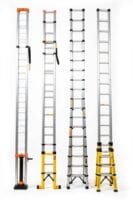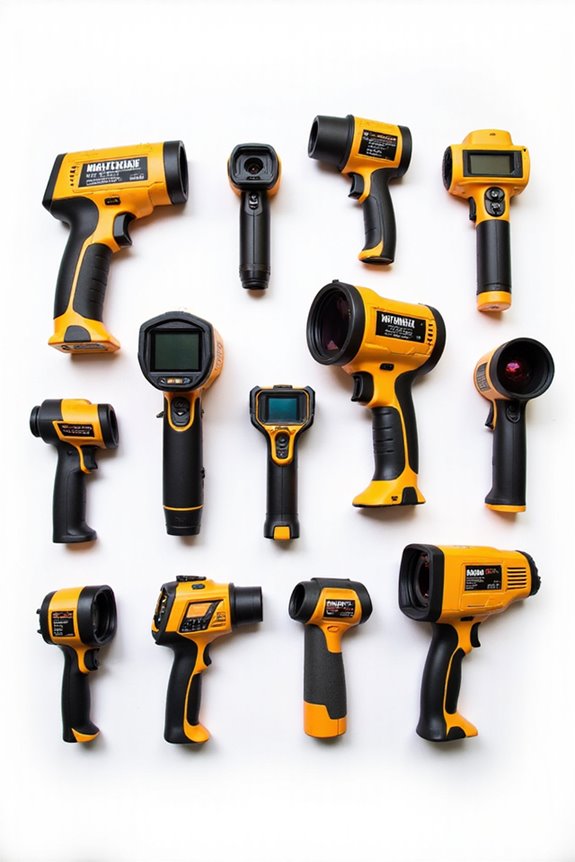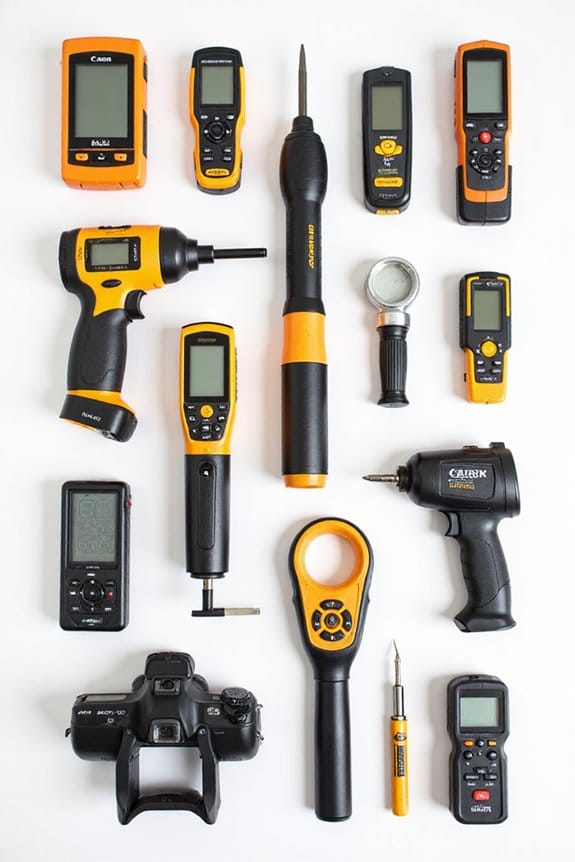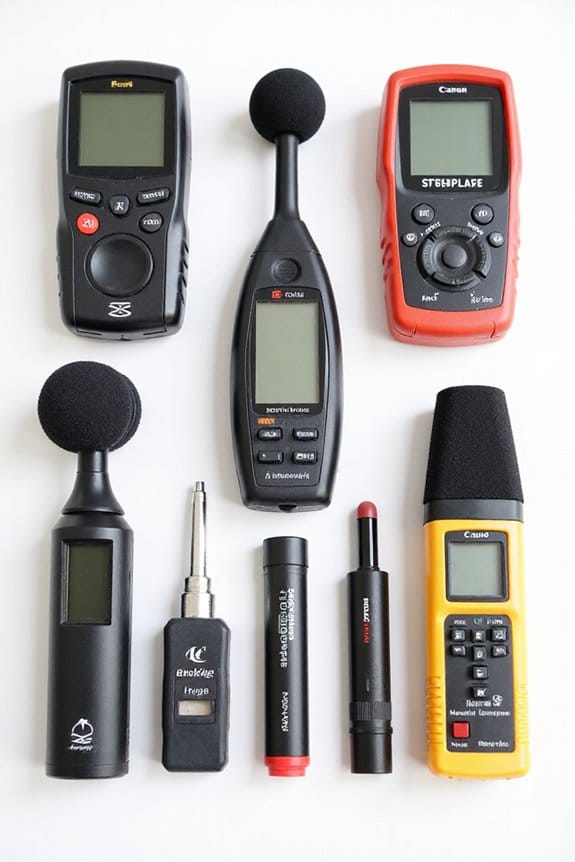As an Amazon Associate, we earn from qualifying purchases. Some links may be affiliate links at no extra cost to you. Although our opinions are based on curated research, we haven't used these products. Articles generated with AI.
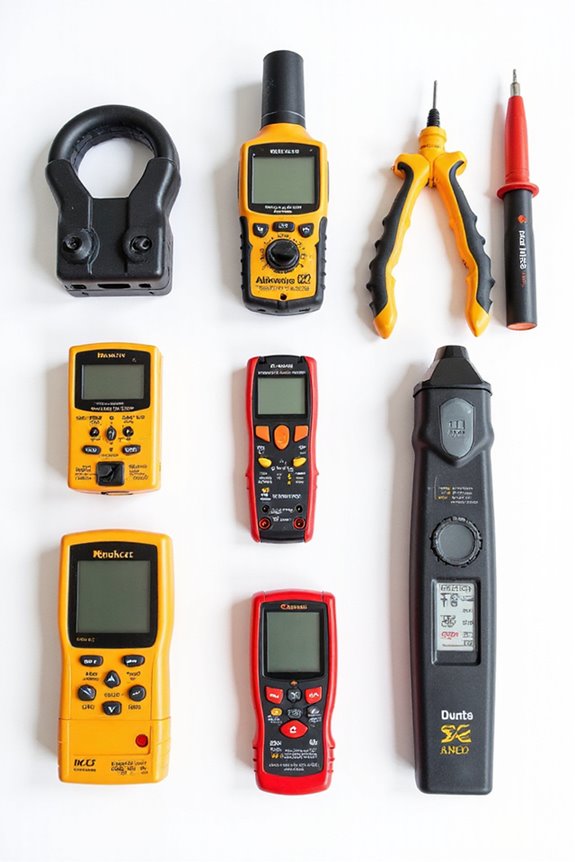
10 Best Non-Contact Electrical Testers for Safe and Accurate Voltage Detection
When it comes to safe voltage detection, here are five testers you shouldn’t miss: 1) The 2PCS Non-Contact AC Voltage Tester Pen is user-friendly and versatile. 2) The Non-Contact Tester with Adjustable Sensitivity lets you choose your voltage range. 3) The Klein Tools Outlet Tester Kit is perfect for home inspections. 4) KAIWEETS offers an LCD display. 5) Southwire’s Detector is ideal for electricians. Want to know the other five and tips on choosing the best? Stick around!
Key Takeaways
- Look for testers with a voltage detection range of 12V to 1000V for versatile applications.
- Choose models with adjustable sensitivity settings for accurate detection in various environments.
- Prioritize safety compliance, such as CAT III or IV ratings, for professional and home use.
- Consider usability features like ergonomic design, built-in flashlights, and auto power-off for convenience.
- Review user feedback on durability and accuracy to ensure reliable performance in real-world situations.
2PCS Non-Contact AC Voltage Tester Pen
LETONNEY 2PCS Voltage Tester, Non Contact AC Voltage Tester Pen, Breakpoint Finder, Dual Range...
- NCV: Equipped with an AC voltage sensing probe, the voltage tester will emit a red light alarm when near an outlet or power line, indicating the presence of voltage
- Dual Range: Detects standard and low voltage (12-1000V / 48-1000V AC) Press the "S" key to switch sensitivity
- Easy to use: The electrical tester can be easily used by men and women of all ages, including electricians, DIY enthusiasts, professionals, hobbyists, and homeowners,...
The PCS Non-Contact AC Voltage Tester Pen is an excellent choice for anyone who needs to quickly and safely check for voltage presence—whether you’re a seasoned electrician or just a DIY enthusiast. Here’s why it stands out:
- Dual Range Detection: It detects 12V-1000V and 48V-1000V AC, covering most household needs.
- User-Friendly Features: With a buzzer, flashing LED alarm, and built-in LED flashlight, it’s perfect for dark corners or power outages.
- Safety Compliance: It meets CE CAT III 600V and RoHS standards, ensuring peace of mind.
Best For: The 2PCS Non-Contact AC Voltage Tester Pen is best for electricians, DIY enthusiasts, and homeowners who need a reliable tool for quick voltage detection.
Pros:
- Dual range detection for versatile use across different voltage levels (12V-1000V and 48V-1000V AC).
- User-friendly features such as a buzzer, flashing LED alarm, and built-in LED flashlight enhance usability in various conditions.
- Safety compliance with CE CAT III 600V and RoHS standards provides reassurance during operation.
Cons:
- Reports of inconsistent accuracy in detecting voltage levels in certain situations.
- Some users have noted potential tip breakage, raising concerns about durability.
- Low battery indicator may not always be clear, leading to unexpected power failures during use.
Non-Contact Voltage Tester with Adjustable Sensitivity
Auroland Non-Contact Voltage Tester with 9 Gear Adjustable Sensitivity Voltage Detector AC Circuit...
- [Non-contact AC Voltage Tester]: This test pen has NCV sensor, you can detect the presence of AC voltage by simply pressing the power switch and bring the probe of the...
- [Alarm function]: When the AC voltage is detected, the sensor indicator lamp of the tester blinks. The test pen lights up the corresponding signal strength indicator...
- [Adjustable Measurement Range]: The HANMATEK non-contact AC tester can adjust the gear in 9 steps, and the detection range can be freely switched between 12-1000v and...
If you often tackle DIY projects or need a reliable tool for quick electrical checks, a Non-Contact Voltage Tester with Adjustable Sensitivity could be your new best friend. Here’s why:
- Versatile Detection: It detects AC voltage from 12-1000V, with nine adjustable sensitivity settings. This versatility is perfect for various tasks.
- Alarm Function: It features a visual and audible alarm, so you’ll know exactly how strong the signal is—no more guessing!
- Compact and Handy: Lightweight and portable, it fits easily in your toolbox.
- LED Flashlight: The built-in flashlight is a lifesaver in dark corners.
Just remember, while it’s great for casual users, pros might want something sturdier!
Best For: Casual DIY enthusiasts and homeowners looking for a reliable tool for quick electrical checks without the need for professional-grade equipment.
Pros:
- Versatile detection with adjustable sensitivity settings from 12-1000V, accommodating various tasks.
- Compact and portable design makes it easy to carry for on-the-go use.
- Built-in LED flashlight provides added convenience for working in dark areas.
Cons:
- Mixed reviews on durability, with some users reporting issues with the casing and reliability.
- Instructions can be difficult to read due to small font size, requiring additional tools like a magnifying glass.
- May not meet professional standards, leading to dissatisfaction for experienced electricians.
Klein Tools Outlet Tester Kit (2-Piece)
Sale
Klein Tools 80025 Outlet Tester Kit with GFCI Tester and Non-Contact Voltage Test Pen, 2-Piece
- SMART BUY: A complete, high-performance kit that offers convenience and value
- COMPLETE OUTLET TESTER TOOL KIT: Includes GFCI Tester (Cat. No. RT210) and Non-Contact Voltage Tester Pen (Cat. No. NCVT1P)
- DETECT COMMON WIRING PROBLEMS: Quickly identifies wiring issues in standard and GFCI receptacles
Looking for a reliable toolset that’s perfect for home inspections? The Klein Tools Outlet Tester Kit (2-Piece) has got you covered! This kit includes a GFCI Tester and a Non-Contact Voltage Tester, making it a must-have for checking wiring issues.
- Bright LEDs: The high-intensity green LED shows operational status, while the red LED alerts you to voltage detection.
- Easy Operation: A digitally controlled ON/OFF power button makes it super user-friendly.
- User-Friendly Chart: It comes with a handy chart to help interpret LED results.
Whether you’re a pro or a DIY enthusiast, this kit’s reliability is hard to beat!
Best For: Homeowners and maintenance workers looking for reliable tools for electrical testing and troubleshooting.
Pros:
- Bright LED indicators for clear operational status and voltage detection.
- User-friendly design with a digital ON/OFF power button for easy operation.
- Includes a helpful chart for interpreting test results, enhancing usability.
Cons:
- Limited to standard and GFCI receptacles, may not cover all electrical issues.
- Non-contact voltage detection may not be as precise as contact testing.
- Requires batteries for operation, which may need regular replacement.
KAIWEETS Non-Contact Voltage Tester with LCD Display
Sale
KAIWEETS Voltage Tester/Non-Contact Voltage Tester with Signal Percentage, Dual Range AC...
- SAFETY FIRST: It will send out multiple alarms through sound and light. When the voltage is detected, the tip will send out red light and beep. When the higher the sensed...
- NON-CONTACT: With NCV inductive probe for AC voltage; Just place the tip near a terminal strip, outlet, or supply cord. When the tip glows red and the pen beeps, you know...
- DUAL RANGE: Detects standard and low voltage (12-1000V AC / 70-1000V AC) for more sensitive and flexible measurements. Press the S button to adjust sensitivity and adapt...
For anyone serious about electrical safety, the KAIWEETS Non-Contact Voltage Tester with LCD Display stands out as a reliable tool. Here’s what makes it shine:
- Dual Voltage Detection: It detects AC voltage from 12V to 1000V, covering a wide range of applications.
- User-Friendly LCD Display: The digital readout shows voltage intensity, making it easy to understand.
- Multiple Alarms: You’ll get sound and light alerts for both high and low voltages—safety first!
- Compact Design: It fits in your pocket and even includes a flashlight for those dimly lit areas.
Just keep in mind, some users found the beeping a bit loud!
Best For: The KAIWEETS Non-Contact Voltage Tester is best for electricians, DIY enthusiasts, and anyone looking to ensure safety while working with electrical systems.
Pros:
- Dual Voltage Detection: Covers a wide range from 12V to 1000V for versatile applications.
- User-Friendly LCD Display: Provides clear digital readout for easy voltage identification.
- Multiple Alarms: Features sound and light alerts for both high and low voltage detection.
Cons:
- Loud Beeping Alarm: Some users find the beeping excessively loud with no volume control option.
- Rechargeable Battery Issues: Some users experienced performance issues with rechargeable batteries, preferring alkaline alternatives.
- Limitations in Voltage Detection: Users recommend caution in relying solely on this device for voltage detection due to potential limitations.
Southwire Tools 40116N NCV Detector 100-600V AC
Sale
Southwire Tools 40116N NCV Detector 100-600V AC
- Southwire Pen style voltage tester
- AUDIBLE AND VISUAL INDICATION of AC voltage from 100-600V AC
- INCREASED BATTERY LIFE: the auto power off feature increases the battery life by powering off after 5 minuets of inactivity
The Southwire Tools 40116N NCV Detector 100-600V AC is a game-changer for electricians and DIY enthusiasts alike. Here’s what makes it stand out:
- Detection Range: It detects AC voltage between 100-600V, giving you a solid range for most tasks.
- User-Friendly: With its pen-style design, it’s easy to handle. A green LED signals readiness, while a built-in flashlight helps in dim areas.
- Safety First: It boasts a CAT IV 600V safety rating, ensuring you stay safe while working.
- Smart Features: The auto power-off feature saves battery life, turning off after five minutes of inactivity.
Best For: Electricians, appliance installers, and DIY enthusiasts seeking a reliable and easy-to-use voltage detection tool.
Pros:
- Highly sensitive with audible and visual indications for accurate voltage detection.
- Compact and durable design, making it easy to handle and transport.
- Auto power-off feature helps conserve battery life.
Cons:
- May produce occasional false positives, requiring users to test the unit before use.
- Not suitable for Tamper Resistant (TR) outlets.
- Suggestions for brighter colors and a dedicated flashlight switch for improved usability.
KAIWEETS Non-Contact Voltage Tester
Sale
KAIWEETS Voltage Tester/Non-Contact Voltage Tester with Signal Percentage, Dual Range AC...
- SAFETY FIRST: It will send out multiple alarms through sound and light. When the voltage is detected, the tip will send out red light and beep. When the higher the sensed...
- NON-CONTACT: With NCV inductive probe for AC voltage; Just place the tip near a terminal strip, outlet, or supply cord. When the tip glows red and the pen beeps, you know...
- DUAL RANGE: Detects standard and low voltage (12-1000V AC / 70-1000V AC) for more sensitive and flexible measurements. Press the S button to adjust sensitivity and adapt...
If you’re looking for a reliable tool to enhance your electrical safety, the KAIWEETS Non-Contact Voltage Tester is a fantastic choice. Here’s why you might want to take it into account:
- Dual Voltage Detection: It detects AC voltage in two ranges—12V-1000V and 70V-1000V—making it versatile.
- User-Friendly Design: With an LCD display and intuitive readout, you can easily see voltage intensity.
- Safety First: Multiple alarms alert you to voltage presence, with a handy flashlight for dim spots.
Just remember, while it’s great for safety checks, don’t rely solely on it for all your voltage needs!
Best For: Electrical professionals and DIY enthusiasts seeking a safe and efficient way to detect AC voltage in various applications.
Pros:
- Dual voltage detection in two ranges (12V-1000V and 70V-1000V) for versatility.
- User-friendly design featuring an LCD display and intuitive readout for easy voltage identification.
- Safety features including multiple alarms and a built-in flashlight for use in low-light conditions.
Cons:
- The beeping alarm may be excessively loud for some users without a volume control option.
- Some users have reported issues with rechargeable batteries, preferring alkaline alternatives.
- Caution is recommended as it shouldn’t be relied upon solely for all voltage detection needs.
Fluke 1AC II VoltAlert Non-Contact Voltage Tester
Sale
Fluke 1AC II VoltAlert Non-Contact Voltage Tester, Pocket-Sized, 90-1000V AC, Audible Beeper, CAT IV...
- Be aware of voltage easily - the tip glows red and a beeper sounds when voltage is detected
- Continuous self-test so you always know it’s working
- Voltage detection range for wide application use - 90 V to 1000 V AC or 200 V to 1000 V AC
Looking for a reliable tool to help you navigate electrical work safely? The Fluke 1AC II VoltAlert Non-Contact Voltage Tester is a top pick for both pros and DIYers. Here’s why it stands out:
- Detection Range: It detects AC voltage from 90-1000V, giving you versatility.
- Safety First: With a CAT IV safety rating, you can work confidently.
- User-Friendly: A glowing red tip and an audible beeper alert you to live wires.
- Compact Design: Easily fits in your pocket, so you can take it anywhere.
Trust me, this tool’s reliability will make your electrical tasks safer and easier!
Best For: The Fluke 1AC II VoltAlert Non-Contact Voltage Tester is best for electricians, maintenance personnel, and DIY enthusiasts who need a reliable and safe way to detect live voltages.
Pros:
- Compact and portable design makes it easy to carry and use anywhere.
- High detection range (90-1000V AC) suitable for various electrical tasks.
- Continuous self-test feature ensures operational integrity and safety.
Cons:
- Some users have reported that the clips can break after extended use.
- A request for a more durable clip or replaceable housing has been noted.
- May be pricier compared to similar products on the market.
WGGE AC Voltage Tester/Non-Contact Voltage Tester with LCD Display
WGGE AC Voltage Tester/Non-Contact Voltage Tester with Dual Range AC 12V-1000V/48V-1000V, Electrical...
- 🔌 【Dual Range AC Voltage Detection】: Detects both low (12–1000V) and high (48–1000V) AC voltage levels, making it ideal for a wide range of residential,...
- ✅ 【Safe & Non-Contact Voltage Testing】: No direct wire contact needed—simply bring the NCV probe close to outlets, wires, or terminals. A red light and audible...
- 📊 【LCD Display with Smart Visual & Audio Alerts】: The clear LCD screen displays voltage status with intuitive color-coded feedback: red screen for high...
For DIY enthusiasts and professional electricians alike, the WGGE AC Voltage Tester/Non-Contact Voltage Tester is a standout choice. Here’s why you might want to grab one:
- Dual Voltage Detection: It detects AC voltage from 12–1000V and 48–1000V, so you’re covered for most tasks.
- Safety Features: Non-contact testing means you won’t zap yourself. It alerts you with a red light and buzzer for live voltage.
- LCD Display: The color-coded screen lets you quickly see voltage status—red for danger, green for all clear.
- Built-In Flashlight: Handy for those dark corners where electrical gremlins hide.
With a slim design, this tester fits nicely in your pocket. Plus, you get 24/7 customer support—because who doesn’t love a safety net?
Best For: The WGGE AC Voltage Tester is best for DIY enthusiasts and professional electricians who need a reliable and safe tool for voltage detection.
Pros:
- Dual voltage detection for versatile use across various applications (12–1000V and 48–1000V).
- Safety features including non-contact testing and audible/visual alerts for live voltage.
- Compact and lightweight design makes it easy to carry and use in tight spaces.
Cons:
- Mixed reviews regarding the clarity of instructions and button quality.
- Some users report issues with flashlight functionality and overall durability.
- Automatic shut-off may be inconvenient for some users who prefer continuous operation.
Wintact Non-Contact AC Voltage Detector Pen (Dual Range)
Wintact Non-Contact AC Voltage Detector Pen, 12V-1000V/48V-1000V Dual Range, High/Low Adjustable...
- Help You Avoid Dangerous Shock: The fully insulated probe tip eliminates the risk of contacting live electrical wires enabling you to test or install electrical equipment...
- Easy to Use: Place the tip of a non-contact voltage tester near a device or wire where AC voltage is present. by emitting an ear-piercing beep or the tip glowing red for...
- Dual Range (12 -1000 V/48V- 1000V): Press the S button to adjust sensitivity can choose according to your needs to detect voltage on AC electric throughout the home:...
The Wintact Non-Contact AC Voltage Detector Pen is an excellent choice for both DIY enthusiasts and professionals who want a reliable, user-friendly tool for electrical testing.
- Dual Range: Detects voltages from 12V to 1000V, ensuring versatility.
- High/Low Sensitivity: Adjust sensitivity based on your needs.
- Safety First: Fully insulated tip and an audible alarm keep you safe.
- Convenience: With a built-in flashlight and a pen hook, it’s perfect for dark spaces.
- Customer Support: You get a warranty and a 24/7 support team ready to help.
It’s a handy tool that makes voltage detection feel like a breeze!
Best For: The Wintact Non-Contact AC Voltage Detector Pen is best for DIY enthusiasts and professionals looking for a reliable and user-friendly tool for electrical testing.
Pros:
- Easy to use with dual voltage detection range from 12V to 1000V.
- High/Low adjustable sensitivity for versatile testing needs.
- Safety features include a fully insulated probe tip and audible alarm for high voltage detection.
Cons:
- Some users report reliability issues with specific applications, such as testing Christmas lights.
- There are mentions of quality concerns, including failures of the LED light.
- Mixed feedback on performance in detecting low voltage situations.
Klein Tools NCVT3P Dual Range Non Contact Voltage Tester
Klein Tools NCVT3P Dual Range Non Contact Voltage Tester, 12-1000V AC Pen, Flashlight, Audible and...
- VERSATILE VOLTAGE DETECTION: This Voltage Tester offers non-contact detection of low voltage in security, entertainment, communications, environmental control, and...
- CLEAR INDICATION: Bright LED illuminates green to indicate tester is operational and flashes red and emits a beeping alert when voltage is detected
- BRIGHT FLASHLIGHT: Equipped with a bright flashlight, this tester illuminates the work area, allowing for enhanced visibility. The flashlight can also be used...
When it comes to tackling electrical tasks, the Klein Tools NCVT3P Dual Range Non-Contact Voltage Tester stands out as a reliable companion for electricians and DIY enthusiasts alike. Here’s what you need to know:
- Voltage Detection: It detects 12-1000V AC, perfect for various applications, from home wiring to entertainment systems.
- Indicators: A green light means no voltage, while a red light and an audible alarm confirm voltage presence.
- Design: Its lightweight, pen-like shape fits easily in your pocket, and a built-in flashlight is handy for dark spots.
- Safety: With a CAT IV 1000V rating, you can test live wires safely.
Best For: The Klein Tools NCVT3P Dual Range Non-Contact Voltage Tester is best for electricians, DIY enthusiasts, and anyone needing reliable voltage detection in electrical systems.
Pros:
- Lightweight and portable design with a pocket clip for easy carrying.
- Clear visual and audible indicators for quick voltage detection.
- High safety rating (CAT IV 1000V) ensures reliable use around live wires.
Cons:
- Some users report sensitivity issues leading to false positives on open circuits.
- Requires two AAA batteries, which some find deplete quickly with frequent use.
- Higher price point compared to basic voltage testers may deter budget-conscious buyers.
Factors to Consider When Choosing a Non-Contact Electrical Tester
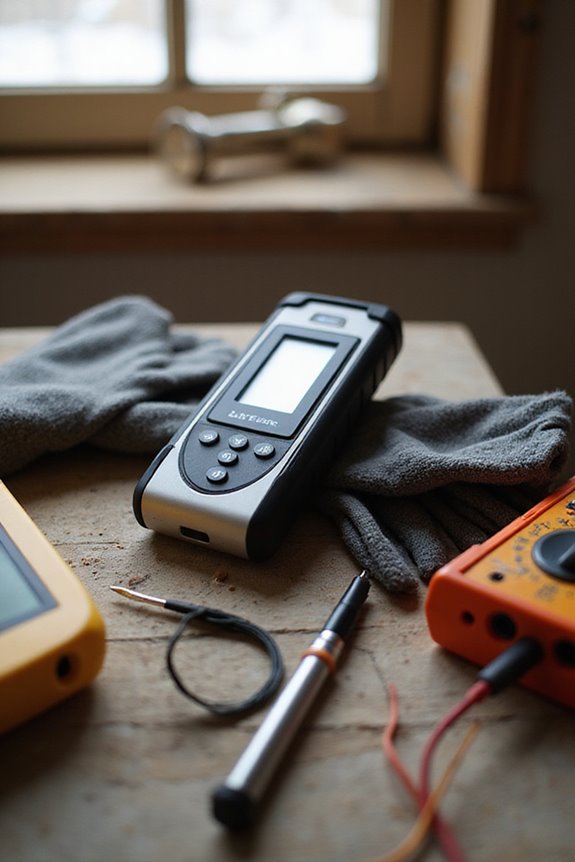
When you’re picking a non-contact electrical tester, there are a few key factors to keep in mind. First, think about the voltage detection range—after all, you don’t want to miss an important signal! Next, consider safety ratings, sensitivity options, and usability; these features can make your testing experience both safe and efficient.
Voltage Detection Range
Choosing the right voltage detection range for your non-contact electrical tester is key to ensuring safety and accuracy during your electrical projects. Here are a few factors to evaluate:
- Voltage Span: Most testers detect from 12V to 1000V AC. This range covers various applications, from household to industrial settings.
- Dual-Range Options: Some testers let you switch between 12-100V and 100-1000V. This feature adds flexibility, making it easier to tackle different tasks.
- Safety Compliance: For professional work, look for testers that handle higher voltages, like 600V or 1000V. It keeps you safe and compliant.
- Indication Alerts: Check how the tester signals voltage presence—LEDs or buzzers can vary in sensitivity.
Pick wisely, and you’ll avoid false readings!
Safety Ratings and Standards
Safety ratings and standards play an important role in selecting a non-contact electrical tester, especially if you want to avoid shocking surprises. Here are a few key factors to take into account:
- CAT Ratings: Look for CAT III 1000V for testing distribution points or CAT IV 600V for working directly at low-voltage sources. These ratings guarantee your tester is fit for the job.
- Certifications: Check for safety certifications like CE and RoHS, which confirm compliance with environmental and safety regulations.
- Low Battery Indicator: This feature alerts you to battery status, helping prevent unexpected failures during testing.
- Double Insulation: This vital feature protects you from electric shock by adding an extra layer of safety. Always choose testers with these ratings for your peace of mind!
Sensitivity Adjustment Options
Selecting the right non-contact electrical tester goes beyond just checking safety ratings; sensitivity adjustment options can greatly impact your testing experience. Here’s what to keep in mind:
- Versatility: Look for testers that let you switch between voltage detection ranges. This feature is handy for distinguishing low and high voltage lines.
- False Positives: Multiple sensitivity settings reduce false positives, especially in insulated wires or low voltage scenarios.
- Environment Suitability: Adjustable sensitivity levels guarantee accurate readings in both residential and commercial settings.
- Convenience: Some testers have a dedicated button for easy toggling between sensitivity levels, so you won’t need to switch tools constantly.
- Safety: Enhanced sensitivity reduces the risk of missing live wires, especially in complex electrical systems.
Having the right sensitivity can make all the difference!
Usability and Design
When you’re in the market for a non-contact electrical tester, usability and design are key factors that can make your experience smoother and more efficient. Here are some aspects to evaluate:
- Ergonomics: Look for comfortable grips and intuitive button placements. This helps reduce fatigue during long jobs—trust me, your hands will thank you!
- LED Flashlight: A built-in flashlight is a lifesaver for dark areas. You want to see what you’re testing, right?
- Indicators: Clear visual and audible alerts make it easy to understand voltage presence without complicated readings.
- Auto Power-Off: This feature conserves battery life, so you’re always ready to use your tester when needed.
With these features, you’ll find a tester that’s not only functional but also user-friendly!
Portability and Size
Choosing the right non-contact electrical tester means paying attention to portability and size. Here are some factors to evaluate:
- Weight and Compactness: Look for lightweight, compact models that easily fit in your pocket or tool belt. You don’t want to lug around extra weight!
- Slim Design: A pen-like shape enhances maneuverability, letting you reach tight spots effortlessly.
- Comfortable Grip: A good grip is essential, especially during prolonged use.
- Pocket Clip: Many testers come with a pocket clip, keeping them secure and preventing loss.
- Battery Management: Features like auto power-off save battery life, making your tester more user-friendly.
Ultimately, a portable, well-designed tester makes your electrical work safer and more efficient!
Additional Features Included
After ensuring your non-contact electrical tester is portable and easy to handle, it’s time to explore the additional features that can make your tasks even smoother. Here are some key features to look for:
- Built-In LED Flashlight: Great for low-light situations—because who wants to fumble around in the dark?
- Adjustable Sensitivity Settings: Switch between high and low voltage detection. Versatility is key!
- Audible Alarms and Visual Indicators: These handy alerts let you know when voltage is present. Safety first!
- Automatic Power-Off: This feature helps conserve battery life—your tester will thank you.
- LCD Displays: Real-time voltage readings provide more detailed feedback than basic lights. Knowledge is power!
These features can make your testing experience safer and more efficient.
Price and Value
Price plays a significant role when you’re on the hunt for a non-contact electrical tester, and it typically ranges from $8 to $100. Here’s what to keep in mind:
- Functionality: Budget models work for occasional users, while pricier ones offer advanced features and durability.
- Voltage Detection: Higher voltage detection (like 1000V) usually means a higher price tag compared to lower ranges.
- Reliability: You don’t want false positives ruining your day. Cheaper testers might compromise safety.
- Extra Features: Adjustable sensitivity and built-in flashlights can justify the cost.
- Warranty: Longer warranties and good customer support often indicate a solid investment.
Frequently Asked Questions
How Do Non-Contact Voltage Testers Work?
Non-contact voltage testers work like magic wands for electricians. Here’s how they do it:
- Electric Field Detection: They sense the electric field around live wires.
- Indicator Light: When you get close, a light or beep alerts you—no touching required!
- Safety First: You can check power without risk, keeping your fingers safely away.
Are Non-Contact Testers Safe for Household Use?
Yes, non-contact testers are safe for household use! Here’s why:
- User-Friendly: You don’t need to touch live wires, reducing shock risk.
- Quick Checks: They help you find voltage without fuss, making inspections easier.
- Visual Alerts: Most testers light up or beep when they detect voltage, providing clear signals.
Just remember, while they’re reliable, always follow safety guidelines. Trust me, a little caution goes a long way in keeping you safe!
Can These Testers Detect DC Voltage?
Yes, non-contact testers can detect AC voltage, but they usually struggle with DC voltage. Here’s a quick breakdown for you:
- AC Voltage: Most testers are designed for this and work great.
- DC Voltage: Not so much! You might need a multimeter for accurate readings.
How Often Should I Calibrate My Voltage Tester?
Did you know that about 30% of voltage testers can drift out of calibration over time? You should calibrate your voltage tester at least once a year. Here’s a quick guide:
- Daily Use: If you use it daily, consider calibrating every six months.
- Environment: In harsh conditions, check more often.
- Accuracy Needs: For critical measurements, annual checks are a must.
Keeping it calibrated helps guarantee your readings are spot on!
What Is the Typical Battery Life of These Testers?
The typical battery life of non-contact voltage testers varies but generally lasts between 6 months to 2 years. Here’s a quick breakdown:
- Usage Frequency: If you’re using it daily, expect shorter life.
- Battery Type: Some models use replaceable batteries, while others are rechargeable.
- Power-Saving Features: Many testers have auto-off functions that can extend battery life.
Always keep a spare battery handy—trust me, it saves a lot of hassle!



